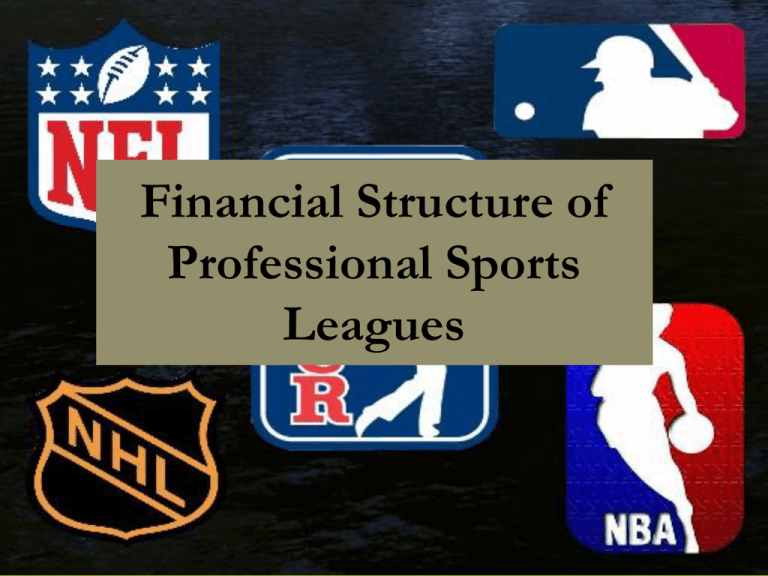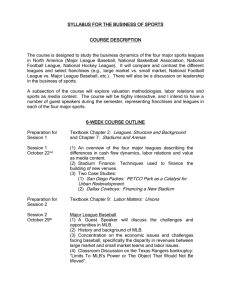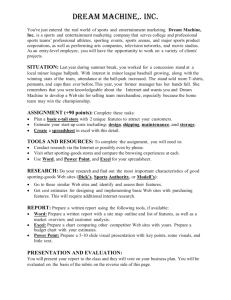Sports Distribution ppt
advertisement

Financial Structure of Professional Sports Leagues Team Sports Professional team sports are finding it increasingly difficult to achieve financial success and turn a profit, due in large part to inflated athlete salaries. FC Barcelona - $217 million, $8.7 million New York Yankees $196 million, $6.2 million Dallas Mavericks - $ 74 million Miami Heat $74 million Buffalo Sabres - $72.6 million Boston Bruins - $64 million Revenue Streams Traditional revenue streams to generate income include: Ticket Sales Sponsorship Licensing & merchandising Concessions Parking Fan clubs Revenue Streams Teams operating today have several additional revenue streams: Luxury suite sales Premium & club seating sales Television contracts (e.g., ABC, CBS, CBC, CTV) Additional media contracts (e.g., satellite, Internet, radio) Costs Facility rental Staff & player salaries Marketing General operating expenses Distributing the Game • Individual teams within a professional league are separately operated businesses, but they are not in competition with each other as they would be in a free open market. • Each team is a member of a cartel. • A cartel is a combination of independent businesses formed to regulate production, pricing, and marketing of a product. Cartels • The professional leagues (NFL, NBA, MLB, NHL, MLS) are all sports cartels • Pro leagues are independent sports teams grouped together and governed by a league agreement • The league controls the marketing mix of the team – product, place, price, promotion. • In most cases cartels are prohibited by federal anti-trust law. • Pro leagues are allowed to have cartels because of special legislation which exempts them from anti-trust laws. Deciding Distribution •Regions with a large potential customer base are considered favourable for a team •Owners try to get public funds to subsidize the team •Tax paid subsidies have to be approved by the voters – often called corporate welfare Attracting A Sports Team • Condition: there are fewer teams than a league can support (low supply, sufficient demand) • The lack of teams forces the cities to compete • Offering the best facilities at the best price helps the cities compete for teams • Until 1960, teams were responsible for their own playing facility • Now cities help support facilities through taxes It’s All About the Money • Some franchises sell the naming rights to their facilities - for large amounts of money (Eg: Air Canada Centre, Centre Bell, The LA Staples Center). • In the 1990’s tax payers began showing resistance to helping pay the bills for athletic facilities • The money a team makes from attendance, broadcasting rights, and concessions pays the salaries for the players • Player salaries continue to rise dramatically It Takes Money • The economics of pro sports involves huge amounts of money and risk on the part of the owners • Few are willing to jeopardize their fortunes without the opportunity to profit from the venture • New stadiums offer luxury suites and upscale restaurants that increase the chances of profits, but these things do not guarantee attracting a team • New stadiums cost around $500 million plus approx. $100 million per year to operate. • New Cowboys Stadium Cost $1 billion Edmonton Oilers – Case Study • Rexall Place is the 3rd oldest arena in NHL (opened in 1974) • The Oilers’ lease on Rexall Place expires in less than two years • Construction on a new building needs to be completed by the 2014-15 NHL season. • Forbes ranks the Oilers in the middle of NHL teams with a worth of US$212-million. • The Oilers routinely sell out their current home at Rexall Place New Arena • The proposed new arena would seat 18,400 with restaurants, shops and enough space to hold parties and even beach volleyball tournaments. Owner – Daryl Katz • ranks among the top 10 wealthiest Canadians (accodring to Forbes, he has a net worth of approximately $2.43 billion). • made his fortune through the Rexall Pharmacy chain. • Katz bought the Oilers team in 2008 for US$200-million. The Problem • Katz and the city of Edmonton are deadlocked over funding for the new downtown arena pegged at $475-million but — when loan payments, land fees and surrounding amenities are factored in — is actually over $700-million and rising. • Katz has said he’s losing money on the Oilers in Edmonton and wants a public subsidy deal similar to the one given to NHL teams in Winnipeg and Pittsburgh. • need an annual $6 million public subsidy to keep the team “viable” in the Alberta capital. (taxpayers to help run the arena – not happy) Who pays for it? • $125-million will come from a tax on tickets (about $5 to $6 a ticket). • the team pays $5.5-million a year in lease payments for three decades. • City pays for construction • the Oilers to run the arena and pay for its upkeep [estimated at $10-million a year], Who makes the $? • Oilers keep all revenues from Oiler games, trade shows, concerts, and other events for 11 months out of the year. Concession sales alone are estimated at $20-million a year. • The team would also get naming rights for the rink (valued between $1-million and $3-million a year) and $20-million from the city over 10 years for unspecified advertising. Solution? Deadlock? • Even with all that, the project would still be short by at least $100-million. • Both sides hope the provincial government will contribute, but Premier Alison Redford has said such a direct subsidy to a for-profit enterprise like the NHL is not in cards. The Big Ticket – TV • The biggest profit center is television revenue • TV revenue is generated through the sale of advertising time • Networks sell ad time and buy the right to air games • The NCAA established a new 14-year television, internet and wireless rights agreement with CBS Sports and Turner Broadcasting System to present the Division I Men’s Basketball Championship beginning in 2011 through 2024 for more than $10.8 billion. Ratings – Getting Viewers • The cost per minute of TV advertising is based on the number of viewers • TV ratings are important in deciding which city gets a professional team • When 3 of the 14 biggest TV markets lost their professional football teams the ratings dropped considerably Other Options • An alternative to the high cost of public financing is community ownership • The local government or the fans own the team – the Green Bay Packers sell stock for the support of their team • Currently public ownership is forbidden in most cases Changes in Rules • Rule changes are being made because of the high cost of franchises and the aging of owners • The NFL has more rules and controls than the other leagues • The MLB & NBA have syndicate ownership in some cases – something the NFL has tried to avoid Vertical Integration in Sports • Sports teams vertically integrate by owning all levels – Minor league teams – Major league teams • Groups own different teams– Maple Leaf Sports Entertainment– owns Air Canada Centre – Manages Toronto Marles & Toronto Maple Leafs – Manages Entertainment Events The End! Maxwell’s Music House http://maxwellsmusichouse.ca/2012/06/maxwells-jam-house-in-the-waterloochronicle/



